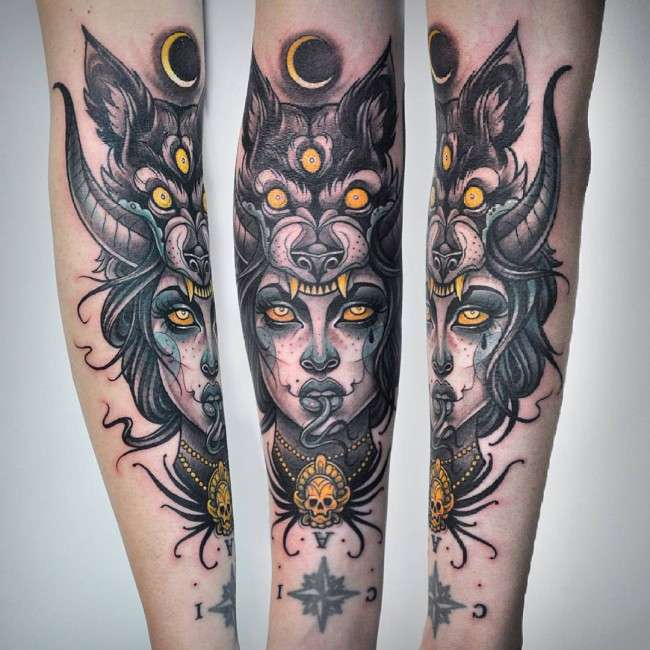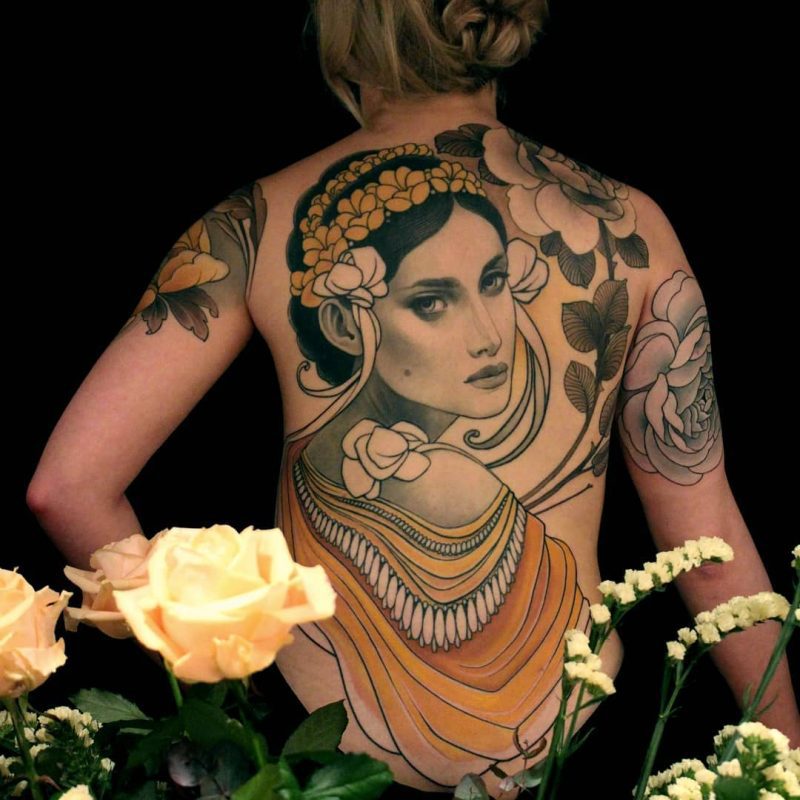
Style Guides: Neotraditional
- Мanagement
- Styles
- neotraditional

Learn the history, influences, and masters of the neo-traditional tattoo style.
- While visually very different from American Traditional, Neotraditional still uses the same basic and fundamental techniques, such as black ink strokes.
- Motifs from Japanese Ukiyo-e, Art Nouveau, and Art Deco prints are all artistic movements that inform and influence neo-traditional tattoos.
- Neotraditional tattoos are known for their rich and luxurious aesthetic, often featuring flowers, portraits of women, animals, and more.
- Anthony Flemming, Miss Juliet, Jacob Wyman, Jen Tonic, Hannah Flowers, Vail Lovett, Heath Clifford, Deborah Cherris, Sadie Glover and Chris Green are considered the best in the business in neo-traditional tattoo styles.
- History and influence of neotraditional tattooing
- Neotraditional tattoo artists
Bright and dramatic colors, often in tones reminiscent of Victorian velvets, lush gemstones or autumnal leaf hues, paired with opulent details such as pearls and delicate lace are what often come to mind when thinking of neo-traditional style. . Arguably the most extravagant aesthetic in tattooing, this distinct style combines American traditional art techniques with a more modern and voluminous approach. In this guide, we'll take a look at the history, influences, and artists who claim the neotraditional method as their own.
History and influence of neotraditional tattooing
While it may sometimes seem far removed from the American traditional style, neotraditional actually follows many of the technical rules of traditional tattooing. Although the line width and weight may vary, black outlines are still standard practice. Clarity of composition, the importance of the black carbon barrier for color retention, and common themes are some of the commonalities. The difference between neo-traditional tattoos and traditional tattoos lies in their more intricate detail, depth of image and unconventionally changing, vibrant color palette.
Perhaps the first historical art movement that immediately manifests itself in a neo-traditional style is Art Nouveau. But to understand Art Nouveau, one must first understand the context and symbolism of what led the movement to flourish.
In 1603, Japan closed its doors to the rest of the world. The floating world sought to protect and preserve its culture, which, due to the pressure of external forces, was under serious threat. However, over 250 years later, in 1862, forty Japanese officials were sent to Europe to discuss opening the heavily guarded gates of Japan. In order to ease tensions between countries and maintain healthy trade relations, goods from the two countries have begun to cross oceans and lands, eagerly awaiting their fingertips.
Interest in Japanese goods was almost fetishistic in Europe, and the craftsmanship of the country had a great influence on future artistic aesthetics. In the late 1870s and 80s, Japanese artwork can be seen that heavily influenced the work of Monet, Degas and Van Gogh. Using flattened perspectives, patterns, and even props such as painted fans and beautifully embroidered kimonos, the Impressionist masters readily adapted Eastern artistic philosophies into their work. Van Gogh even quotes: "We could not study Japanese art, it seems to me, without becoming happier and more cheerful, and this makes us return to nature ..." This influx of Japaneseism and a return to nature, was to ignite the next movement, which had the greatest influence on contemporary neo-traditional tattooing.
The Art Nouveau style, most popular and used between 1890 and 1910, continues to inspire artists today, including neotraditional tattoo artists. The style was heavily influenced by oriental artworks that were exhibited in Europe at the time. The obsession with Japanese aesthetics was in full swing, and in Art Nouveau, similar lines and color stories can be seen that are very similar to ukiyo-e woodcuts. This movement is not limited to aspects of 2D visual art, it has influenced architecture, interior design, and more. Beauty and sophistication, delicate filigree details, all miraculously merge with portraits, usually set against the backdrop of lush flowers and natural scenes. Perhaps the best example of this fusion of art forms is Whistler's Peacock Room, completed in 1877, gilded and embellished with a wonderful sense of Asian elements. However, Aubrey Beardsley and Alphonse Mucha are the most famous Art Nouveau artists. In fact, many neo-traditional tattoos replicate Fly's posters and advertisements, either directly or in subtle detail.
Art Deco was the next movement to replace Art Nouveau. With sleeker, more modernized and less romanticized lines, Art Deco was the aesthetic of a new age. Still often exotic in nature, it was more sophisticated than Art Nouveau, which still basked in the excesses of Victorian culture. One can see the influence of Egypt and Africa, in part due to the eruption of the Jazz Age, which was largely buoyed by the energy of a younger generation still recovering from the depression of World War I. Although Art Deco has not influenced neo-traditional tattoos as much as the art of Nouveau, much of the passion, flair and fire of neo-tradition is drawn from this particular cultural movement.
Both of these styles provide a striking and attractive foundation for neotraditionalism.
Neotraditional tattoo artists
While many contemporary tattoo artists have tried to master neo-traditional tattooing, none have been as successful as Anthony Flemming, Miss Juliet, Jacob Wyman, Jen Tonic, Hannah Flowers, Vail Lovett, and Heath Clifford. There are also styles by Deborah Cherris, Grant Lubbock, Ariel Gagnon, Sadie Glover, Chris Green and Mitchell Allenden. While each of these tattoo artists work in the field of neo-traditional tattooing, they all bring a unique and distinct flavor to the style. Heath Clifford and Grant Lubbock concentrate on bold animal concepts, while Anthony Flemming and Ariel Gagnon, though both passionate about animals, often infuse their pieces with decorative details such as pearls, gemstones, crystals, lace and metalwork. Hannah Flowers is known for her magnificent portraits of nymphets and goddesses. You can see references to Klimt and Mucha; their work is regularly referenced in her neo-traditional tattoos. Vale Lovett, who is also an illustrator of animals and women, is perhaps most highly regarded for her large blackwork work, which is often infused with Art Nouveau styles in filigree forms and architectural ornamentation.
Whether adorned with the beautiful glow of white pearls, bathed in warm and gorgeous cool-weather colors, or set in a garden blessed with gold filigree and lush flowers, neotraditional tattoos are known for their dense and luxurious aesthetic. It's not a trend, it's a welcome mainstay in the tattoo community's vast and varied portfolio of stylistic offerings.
Leave a Reply